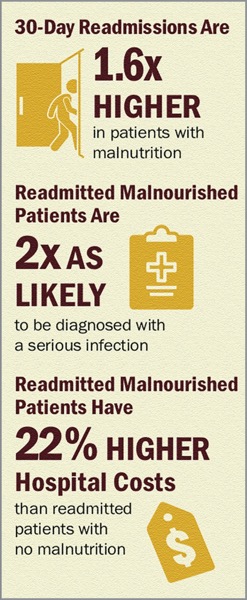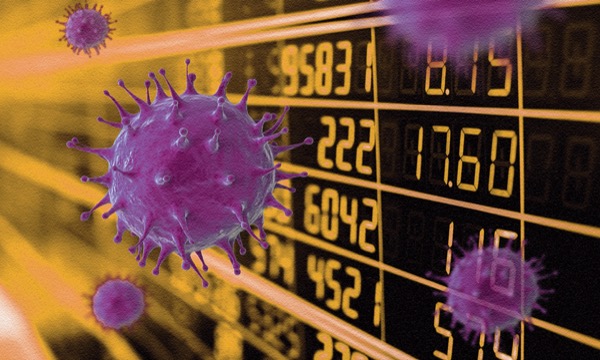By Alison McCook
Nutrition experts are urging providers to screen all COVID-19 patients for malnutrition, based on recent data showing that infected patients’ mortality rates spike significantly in the presence of suboptimal feeding.
The interplay between COVID-19 and nutrition shouldn’t come as a surprise, Leah Gramlich, MD, FRCP, a nutrition specialist with Royal Alexandra Hospital in Edmonton, Alberta, noted during a recent webinar hosted by the American Society for Parenteral and Enteral Nutrition (ASPEN). She explained that patients infected with the coronavirus often have a poor appetite and gastrointestinal symptoms, such as diarrhea, both of which can affect their nutritional status (Gastroenterology 2020;159[2]:775-777).
The survival of such patients literally is at stake, she stressed, citing the new data, which included hundreds of COVID-19 patients in Wuhan, China. The researchers screened patients for nutritional deficiencies using the Nutrition Risk Screening (NRS) score, and found that the vast majority (92%) were at risk for poor nutrition (NRS score ≥3), with 16% at high risk (NRS score ≥5). Patients remained in the hospital for an average of 30 days, but those with NRS scores of at least 5 needed nearly an additional week to recover. Nine percent of the patients died; among those with NRS scores of 5 or higher, the mortality rate was 43% (JPEN J Parenter Enteral Nutr [Epub Jul 1, 2020]. doi:10.1002/jpen.1953).
Hence the push for more widespread nutrition screening in COVID-19 patients. Different countries have developed a variety of screening tools, but “as long as the tool has been validated for use in your patient population and setting,” the effort should yield positive results, Dr. Gramlich said. If the tool shows the patient is at risk for nutritional deficiencies, a dietitian or nutrition care provider can conduct a formal assessment to determine whether malnutrition is present, identify barriers to intake, and develop an individualized plan, she noted. If patients develop any additional risk factors for nutritional deficiencies, such as nausea or poor food intake, they should be screened again.
“Screening is not a one-and-done process,” said Dr. Gramlich, who is also a professor of medicine in the Division of Gastroenterology at the University of Alberta, in Edmonton.
Jay Mirtallo, MS, RPh, a clinical practice specialist at ASPEN who did not participate in the webinar, echoed the importance of widespread screening, and agreed that using a validated screening tool is important. However, if providers don’t have access to such a tool, he noted, simply asking whether patients experienced recent unexplained weight loss, or have food insecurity—such as trouble accessing or preparing food for themselves—could help identify people at risk, he said.

“You need to screen them, and then you have to act on it right away, because malnourishment can happen really quickly,” Dr. Mirtallo said.
Given that urgency, a collaborative approach to nutrition support is key, Dr. Gramlich said. Indeed, “nutrition care is a team sport,” she said. “It requires multidisciplinary, interdisciplinary care.”
Barriers to Nutrition Support
If hospitalized, patients may have to contend with personal protective equipment (PPE), nausea, breathing difficulties and other issues that can impede food intake. There also can be difficulties in providing care: Hospital pharmacists and dietitians may, for example, have to deal with shortages in PPE and recommendations to minimize exposure, Phil Ayers, PharmD, BCNSP, the chief of clinical pharmacy services and a nutrition support service pharmacist at Mississippi Baptist Medical Center, in Jackson, said. Indeed, having a patient be readily accessible for a complete nutrition assessment “is a major challenge for all involved in the treatment of COVID-19 patients,” he said. As a result, “many institutions are using other means to collect this information, such as calling patients, family members, using telehealth, electronic health record review and discussing with the nurse at bedside,” Dr. Ayers said.
Taken together, all of these interventions underscore how invaluable the nutrition care team can be, not only for COVID-19 patients, but for those hospitalized with any condition, Gramlich noted. That’s why she called nutrition experts the “unsung heroes” of health care. When a patient is struggling with maintaining adequate feeding, nutrition experts may not always be the first providers consulted, “but they are a key aspect of recovery,” given how poorly hospitalized patients fare when malnourished, she said (Lancet 2019;393[10188]:2312-2321).
Inflammation May Be The Key
Dr. Mirtallo said he suspects that once researchers learn more about COVID-19, they will discover that its effect on nutritional status “will be as big or bigger than it is for other diseases.”
As for possible mechanisms of action, “it’s still too early to know for sure,” he said. “It’s just too new.” But there is definitely a relationship between COVID-19 and nutrition, he stressed, because the virus creates widespread inflammation, which malnutrition can exacerbate (SN Compr Clin Med 2020;1-5. doi: 10.1007/s42399-020-00410-0).
Regardless of how future studies on COVID-19 and nutrition pan out, there’s no doubt that nutrition care often is neglected, Mr. Mirtallo observed. “It slips through the cracks, because you’re focused on the disease and treatment for the disease, which is mostly drugs,” he said. But as Mirtallo has been reminding his students for 40 years, nutrition is a key aspect of pharmacologic management. “So you can’t really separate the two.”
Gramlich echoed the need for a more inclusive view of nutrition, particularly during the pandemic. “I actually see nutrition care in COVID-19 as a pillar of overall care,” she said. “That pillar of care should be applied to all patients. In the time of COVID-19, it’s even more important.”
Gramlich reported financial relationships with Abbott, Baxter, Fresenius Kabi and Takeda; Ayers with American Regent and Fresenius Kabi; and Mirtallo with Fresenius Kabi.


